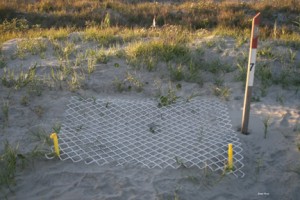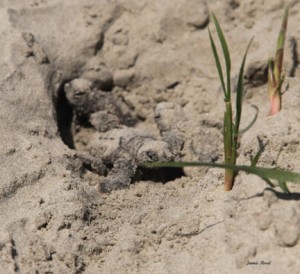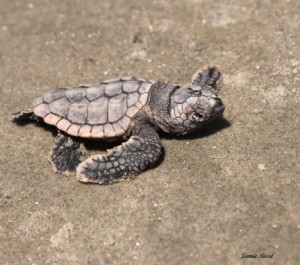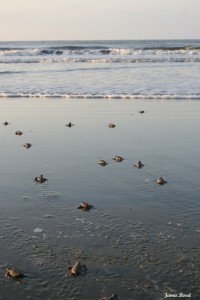post
Loggerhead Turtle Hatching Season

In July the hatching season for loggerhead turtles will officially begin on Kiawah Island in South Carolina. Kiawah provides great nesting habitat for the mother Loggerheads (Caretta caretta) and each summer these large, 350-pound turtles find themselves in our dunes to lay their eggs from mid-May to mid-July with nests hatching now through mid-October.
As of July 10th, Kiawah has recorded 82 nests on the island. These nests are monitored by Kiawah’s volunteer Turtle Patrol in partnership with the South Carolina Department of Natural Resources. The incubation period for each nest is approximately 55-65 days, depending on the temperature, conditions and natural process of development. The first nest of the season was laid on May 17th and that nest and other early nests should begin hatching soon!
A typical nest is shown above. Nest numbers are assigned based on the order they were laid on the beach. Nests are screened to protect against raccoons and other predators.

The hatching process takes place at night, usually when the sand is cooler and hatchlings can feel the vibrations of the evening tides. Averages of 120 Ping-Pong-sized eggs are in each nest, buried 18 inches below the sand. These turtles hatch together – safety in numbers! – and make their way to the ocean. Tiny tracks can usually be seen in the morning emerging from a small depression that once was the nest.
What you can do to help the sea turtles
Lights out for Sea Turtles! – Nesting and hatching typically takes place at night, when the light of the moon can guide the mother, and then later on the hatchlings, back to the ocean. For this reason, it is important to keep beach front lights off during the night-time hours, so the lights of your home do not guide the turtles in the wrong direction. If you are lucky enough to experience nesting or hatching, please also remember to keep your camera flash off as well.
Let them have space! – If you find a nesting or hatching turtle, give them room to move on their own. Mother turtles can complete “false crawls” if something on shore scares or startles them during the nesting process. We can save the female the hard work of crawling onto the beach more times than necessary by giving space and helping make an undisturbed nesting process. Also be sure to remove any beach obstacles, like chairs or left-behind toys, which could get in the way of the nesting or hatching crawl.
Let them learn! – Do not pick up hatchlings when they are on their way to the water. Sea turtles can “imprint” which means they learn the magnetic field of their home beach as they make their way from the dunes to the ocean. This is an amazing form of learning and means that female turtles that hatch here on Kiawah will return to Kiawah to lay their eggs in 12-20 years.
Let them eat! – Loggerhead Sea turtles love to eat jellyfish. Plastic bags, bottles and balloons look a lot like jellyfish when floating in the ocean and can cause the turtle to suffocate or die if swallowed. Collect any plastic litter you find and limit your plastic use in general by using reusable bottles and bags.
Learn! – Join our naturalists for a Night Beach Walk to learn more about these amazing reptiles. This tour is offered Monday-Friday and leaves from West Beach.
Reservations can be made by calling the Heron Park Nature Center at 843.768.6001



This season, nesting on Kiawah has been lower than in recent years. Does this mean fewer turtles are choosing to return to Kiawah? Of course not! Last year’s record breaking nest numbers probably resulted from favorable food and mating conditions, and hopefully from better health of these threatened species in general. Nesting is somewhat cyclical however, so lower nest numbers this year suggest that a few of our returning females are not mating and nesting this year but rather storing up energy for the years ahead.
All photos courtesy of Jamie Cathcart Rood.